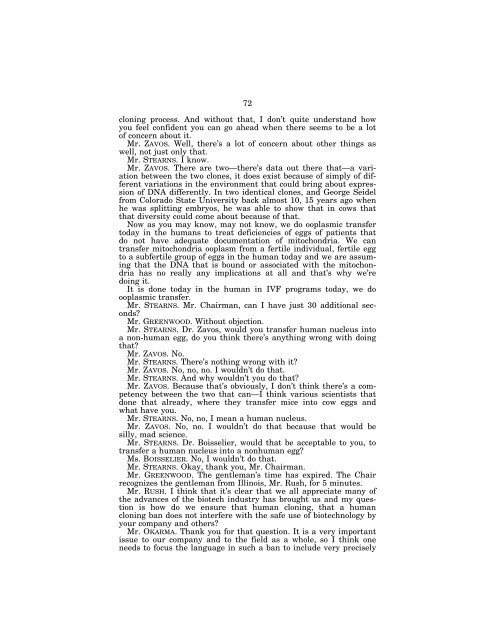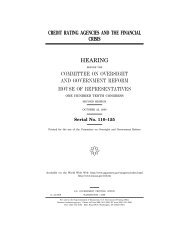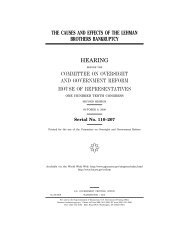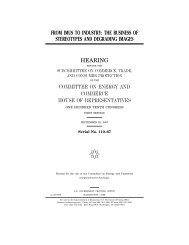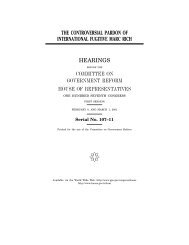72cloning process. And without that, I don’t quite understand howyou feel confident you can go ahead when there seems to be a lotof concern about it.Mr. ZAVOS. Well, there’s a lot of concern about other things aswell, not just only that.Mr. STEARNS. I know.Mr. ZAVOS. There are two—there’s data out there that—a variationbetween the two clones, it does exist because of simply of differentvariations in the environment that could bring about expressionof DNA differently. In two identical clones, and George Seidelfrom Colorado State University back almost 10, 15 years ago whenhe was splitting embryos, he was able to show that in cows thatthat diversity could come about because of that.Now as you may know, may not know, we do ooplasmic transfertoday in the humans to treat deficiencies of eggs of patients thatdo not have adequate documentation of mitochondria. We cantransfer mitochondria ooplasm from a fertile individual, fertile eggto a subfertile group of eggs in the human today and we are assumingthat the DNA that is bound or associated with the mitochondriahas no really any implications at all and that’s why we’redoing it.It is done today in the human in IVF programs today, we doooplasmic transfer.Mr. STEARNS. Mr. Chairman, can I have just 30 additional seconds?Mr. GREENWOOD. Without objection.Mr. STEARNS. Dr. Zavos, would you transfer human nucleus intoa non-human egg, do you think there’s anything wrong with doingthat?Mr. ZAVOS. No.Mr. STEARNS. There’s nothing wrong with it?Mr. ZAVOS. No, no, no. I wouldn’t do that.Mr. STEARNS. And why wouldn’t you do that?Mr. ZAVOS. Because that’s obviously, I don’t think there’s a competencybetween the two that can—I think various scientists thatdone that already, where they transfer mice into cow eggs andwhat have you.Mr. STEARNS. No, no, I mean a human nucleus.Mr. ZAVOS. No, no. I wouldn’t do that because that would besilly, mad science.Mr. STEARNS. Dr. Boisselier, would that be acceptable to you, totransfer a human nucleus into a nonhuman egg?Ms. BOISSELIER. No, I wouldn’t do that.Mr. STEARNS. Okay, thank you, Mr. Chairman.Mr. GREENWOOD. The gentleman’s time has expired. The Chairrecognizes the gentleman from Illinois, Mr. Rush, for 5 minutes.Mr. RUSH. I think that it’s clear that we all appreciate many ofthe advances of the biotech industry has brought us and my questionis how do we ensure that human cloning, that a humancloning ban does not interfere with the safe use of biotechnology byyour company and others?Mr. OKARMA. Thank you for that question. It is a very importantissue to our company and to the field as a whole, so I think oneneeds to focus the language in such a ban to include very preciselyVerDate 11-MAY-2000 07:46 May 24, 2001 Jkt 000000 PO 00000 Frm 00076 Fmt 6633 Sfmt 6602 71495.TXT HCOM2 PsN: HCOM2
73transfers to uteri, to a uterus of these kinds of recombined embryoswith the intent of forming a live birth. That, for us, is the brightline that should not be crossed.Mr. ZAVOS. Can I make a comment, Mr. Rush? I was very impressed,obviously, of your background and your ethical issues thatyou addressed here and I want to bring to this panel a discussion,some sort of a dimension here that everybody needs to understand.What would be the ethical reaction of somebody if we would saythat a 14-day embryo, a 14-day embryo that is used in stem cellresearch can be dismembered and be killed literally to harvestthose stem cells and do research on those stem cells that’s dismemberedas a child. That 14-day embryo is a child by definition.Okay, how can we afford to dismember that embryo and take itapart and take all those cells out of it and clone them or proliferatethem and transfer them to treat somebody else’s disease and it’smorally or ethically incorrect to take a cloned embryo and implantit in a woman to give birth to a live child. If we’re going to startdiscussing ethical issue, that ethical issue here really needs to beaddressed as such.Mr. RUSH. Dr. Jaenisch, would you care to comment?Mr. JAENISCH. I think Dr. Zavos is mixing up things again. Withthe embryo stem cell work, it’s clear that it never goes in the uterus.It’s a blastocyst which develops into an embryonic stem cellsand this is very different than an implanted embryo which is disruptedand used for other research. So I think this is very clear.I would like to really raise the question, are those people readyto produce abnormal children and I think what I appear to hearfrom them, they are. They are ready to do this because there’s justno way to pre-screen embryos and I really reemphasize this, toprescreen embryos for those defects. There’s a misunderstandingalso in the committee. I’d like to try to clarify this. Clones don’thave genetic defects. They have reprogramming problems. And Iwould like to really reemphasize this important point because it’san analogy which I think is familiar to anyone in this room. If youwrite a text, this text, the words has spaces between them, thereis punctuation, there are paragraphs, italics, it makes it easy toread. Now if you just follow my experiment, if you know totally theformat of this text, taking all the spaces out between the words,taking all punctuation away, you will have a lot of problems readingthe text. You cannot read it. This is exactly what I mean withreprogramming. The genes which are not expressed are in this reprogrammedformat. They’re not readable by the cell. The sequencehas not changed. Information is exactly the same. So these geneswhich are expressed in the skin cell, the example I brought, theembryonic genes and the brain genes are not readable. Like thetext, your informed of the text. These nucleus goes to the oocyteinto the egg and now all the 30,000 genes in principle have tomake readable this normally occurring string, egg maturation,sperm maturation which is short-cut in cloning. I think this is thereally very important point, so when they say, on my left, they canprescreen the blastocysts on early embryo for false gene expression,this is again incorrect. Many of the genes that will be expressed inthe genes normally in the brain. I’ve never expressed theblastocysts in the embryo. There’s just no basis even to do this. YouVerDate 11-MAY-2000 07:46 May 24, 2001 Jkt 000000 PO 00000 Frm 00077 Fmt 6633 Sfmt 6602 71495.TXT HCOM2 PsN: HCOM2
- Page 1 and 2:
ISSUES RAISED BY HUMAN CLONING RESE
- Page 3 and 4:
C O N T E N T SPageTestimony of:Boi
- Page 5 and 6:
ISSUES RAISED BY HUMAN CLONINGRESEA
- Page 7 and 8:
3Would human cloning lessen the wor
- Page 9 and 10:
5Chairman TAUZIN. Thank you, Mr. Ch
- Page 11 and 12:
7and cell therapy and beta cell dev
- Page 13:
9safety and the moral condition of
- Page 17 and 18:
13seen in the common phrase, being
- Page 20 and 21:
16a want of capacity to live were a
- Page 22 and 23:
18eight to ten weeks gestation as a
- Page 24 and 25:
20Washington v. Glucksberg ignores
- Page 26 and 27: 22tion decision. The father of ‘
- Page 28 and 29: 24been treated as ‘‘sui generis
- Page 30 and 31: 26Perhaps the three most compelling
- Page 32 and 33: 28are their genes. We know that chi
- Page 34 and 35: 30ago, Nobel Prize-winning biologis
- Page 36 and 37: 32Mr. JOHN. Thank you, Mr. Chairman
- Page 38 and 39: 34Mr. GREENWOOD. The Chair thanks t
- Page 40 and 41: 36to turn undifferentiated human pl
- Page 42 and 43: 38these issues have not yet even be
- Page 44 and 45: 40really have a clue what those gen
- Page 46 and 47: 42mately 150 days of gestation and
- Page 48 and 49: 44Hill JR, Winger QA, Long CR, Loon
- Page 50 and 51: 46clones will not change a bit by t
- Page 52 and 53: 48technologies, we’re able today
- Page 54 and 55: 50from the testes of infertile men
- Page 56 and 57: 52not be taken away from people, be
- Page 58 and 59: 54a result of this declaration, I w
- Page 60 and 61: 56Too much pressure, too many expec
- Page 62 and 63: 58requires some level of scientific
- Page 64 and 65: 60an abnormal person. So I think it
- Page 66 and 67: 62to the world, back to this earthl
- Page 68 and 69: 64which is not true for cow which i
- Page 70 and 71: 66Ms. BOISSELIER. University of Hou
- Page 72 and 73: 68Ms. BOISSELIER. Soon.Ms. DEGETTE.
- Page 74 and 75: 70Mr. ZAVOS. No, no. We believe tha
- Page 78 and 79: 74have to look at the structure of
- Page 80 and 81: 76Mr. LARGENT. So the answer is no,
- Page 82 and 83: 78that very much and you are excuse
- Page 84 and 85: 80that people have incorrectly stat
- Page 86 and 87: 82My name is Dr. Thomas Murray. I
- Page 88 and 89: 84human subjects against irresponsi
- Page 90 and 91: 86might be born as a result of this
- Page 92 and 93: 88ever, it is not unusual for the g
- Page 94 and 95: 90Mr. DEUTSCH. Because there really
- Page 96 and 97: 92Ms. ZOON. When we found out about
- Page 98 and 99: 94Mr. GREENWOOD. The time of the ge
- Page 100 and 101: 96Be that as it may I think there a
- Page 102 and 103: 98There has been progress in the cl
- Page 104 and 105: 100may find that it is a terrible e
- Page 106 and 107: 102entists tried to get this ban ov
- Page 108 and 109: 104lies in our hands. And we face a
- Page 110 and 111: 106clude Ireland, Israel, Italy, Fr
- Page 112 and 113: 108strict IVF and similar high-tech
- Page 114 and 115: 110while ‘‘clone then love’
- Page 116 and 117: 112What Cloning Is Not—The ‘‘
- Page 118 and 119: 114And the largest group of people
- Page 120 and 121: 116The last piece to the legal puzz
- Page 122 and 123: 118cloning law on both scientific f
- Page 124 and 125: 120mendous potential human safety r
- Page 126 and 127:
122age him to do this research and
- Page 128 and 129:
124I realize there have been calls
- Page 130 and 131:
126‘‘from which I have no assoc
- Page 132 and 133:
128TO HAVE CHILDREN,’’ I ask th
- Page 134 and 135:
130of ourselves as humans in our pr
- Page 136 and 137:
132Our Genetic Science Task Force c
- Page 138 and 139:
134But this was also true in occide
- Page 140 and 141:
136So we utilized good science to d
- Page 142 and 143:
138egg and so on. What you’re tal
- Page 144 and 145:
140Mr. DEUTSCH. I think that’s ac
- Page 146 and 147:
142and dad? We all did that when we
- Page 148 and 149:
144Food, Drug and Cosmetics Act or
- Page 150 and 151:
146Mister Chairman, the embryo may
- Page 152 and 153:
148The current low rate of cloning
- Page 154 and 155:
150TIME magazine’s pictorial, ‘
- Page 156 and 157:
152John A. Robertson, University of


